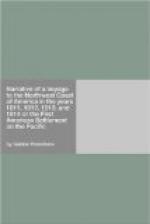[Footnote AH: Pemican, of which I have already spoken several times, is the Indian name for the dried and pounded meat which the natives sell to the traders. About fifty pounds of this meat is placed in a trough (un grand vaisseau fait d’un tronc d’arbre), and about an equal quantity of tallow is melted and poured over it; it is thoroughly mixed into one mass, and when cold, is put up in bags made of undressed buffalo hide, with the hair outside, and sewed up as tightly as possible. The meat thus impregnated with tallow, hardens, and will keep for years. It is eaten without any other preparation; but sometimes wild pears or dried berries are added, which render the flavor more agreeable.]
Having spent the 1st of July in repairing our canoes, we re-embarked on the 2d, and continued to ascend Winipeg river, called also White river, on account of the great number of its cascades, which being very near each other, offer to the sight an almost continuous foam. We made that day twenty-seven portages, all very short. On the 3d, and 4th, we made nine more, and arrived on the 5th, at the Lake of the Woods. This lake takes its name from the great number of woody islands with which it is dotted. Our guide pointed out to me one of these isles, telling me that a Jesuit father had said mass there, and that it was the most remote spot to which those missionaries had ever penetrated. We encamped on one of the islands. The next day the wind did not allow us to make much progress. On the 7th, we gained the entrance of Rainy Lake river. I do not remember ever to have seen elsewhere so many mosquitoes as on the banks of this river. Having landed near a little rapid to lighten the canoes, we had the misfortune, in getting through the brush, to dislodge these insects from under the leaves where they had taken refuge from the rain of the night before; they attached themselves to us, followed us into the canoes, and tormented us all the remainder of the day.




